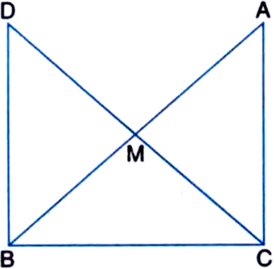 Short Answer Type
Short Answer Type

(i) ∆ABD ≅ ∆BAC
(ii) BD = AC
(iii) ∠ABD = ∠BAC.


Line I is the bisector of an angle ∠A and B is any point on I. BP and BQ are perpendiculars from B to the arms of ∠A (see figure). Show that:
(i) ∆APB ≅ ∆AQB
(ii) BP = BQ or B is equidistant from the arms of ∠A.
(i) ∆DAP ≅ ∆EBP
(ii) AD = BE.

Given: AB is a line segment and P is its mid-point. D and E are points on the same side of AB such that ∠BAD = ∠ABE and ∠EPA = ∠DPB.
To Prove: (i) ∆DAP ≅ ∆EBP
(ii) AD = BE.
Proof: (i) In ∆DAP and ∆EBP,
AP = BP
| ∵ P is the mid-point of the line segment AB
∠DAP = ∠EBP | Given
∠EPA = ∠DPB | Given
⇒ ∠EPA + ∠EPD = ∠EPD + ∠DPB
| Adding ∠EPD to both sides
⇒ ∠APD = ∠BPE
∴ ∠DAP ≅ ∠EBP | ASA Rule
(ii) ∵ ∆DAP ≅ AEBP | From (i) above
∴ AD = BE. | C.P.C.T.
 Long Answer Type
Long Answer Type
(i) ∆AMC ≅ ∆BMD
(ii) ∠DBC is a right angle
(iii) ∆DBC ≅ ∆ACB![]()
 Short Answer Type
Short Answer Type
